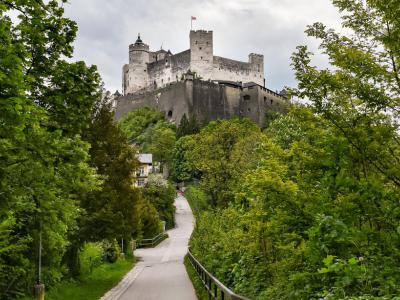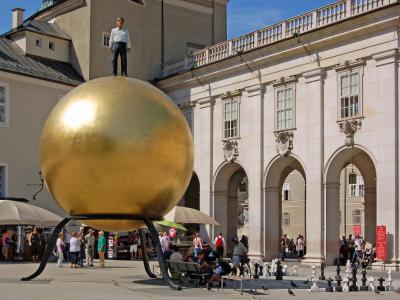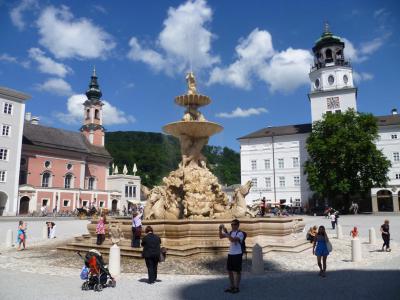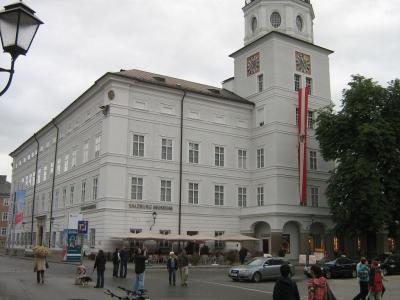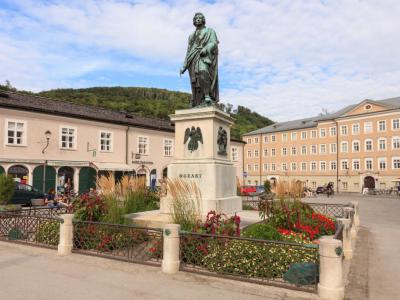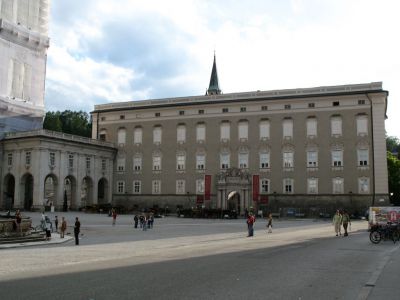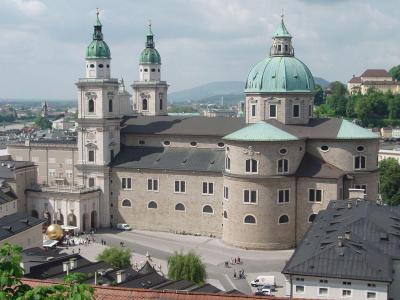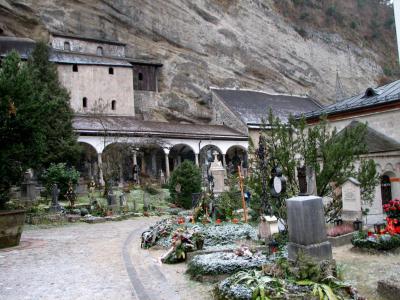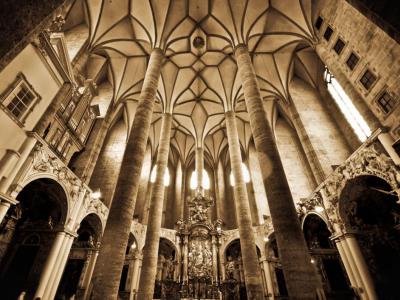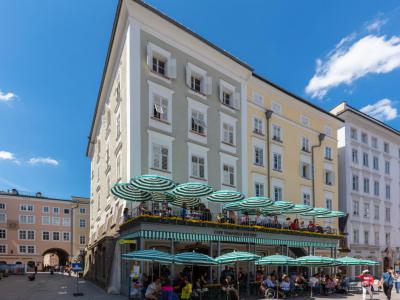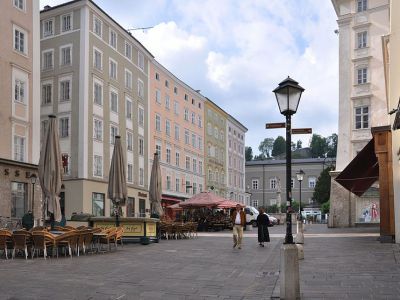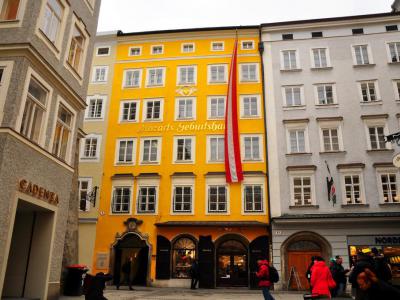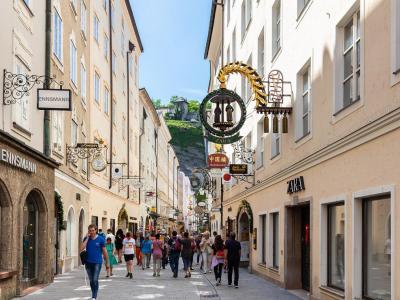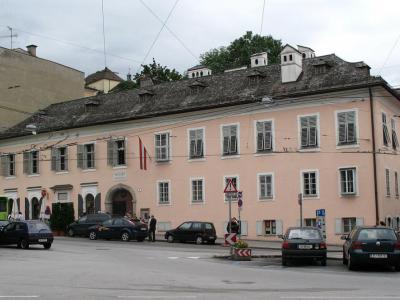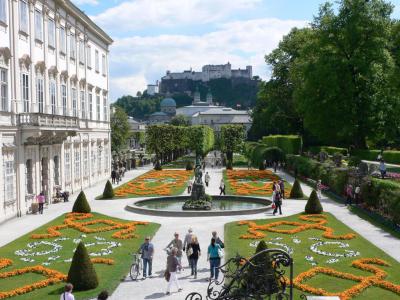
Salzburg Introduction Walking Tour (Self Guided), Salzburg
Dubbed the "City of Mozart", the enchanting Austrian city of Salzburg has gone down in history primarily as the hometown of its greatest son, Wolfgang Amadeus Mozart. His birthplace on Getreidegasse, a busy shopping street, is now a museum, much like the Mozart Residence, a place where the 18th-century composer spent much of his early life.
Apart from Mozart, however, Salzburg is also famous for its Medieval and Baroque architecture, as well as for the abundance of squares, the bustling hubs of activity, such as Chapter Square (Kapitelplatz) and Residence Square (Residenzplatz). The latter is home to the magnificent Residence Palace, a former dwelling of the Archbishops of Salzburg.
The city was founded, as an episcopal see, on the site of the Roman settlement of Iuvavum in 696. Its main sources of income were salt extraction, trade, as well as gold mining.
The name "Salzburg" is made up of two German words – "salz" (which means salt) and "burg" (meaning fortress) – and derived from the barges that carried salt on the River Salzach and were subject to a toll, back in the 8th century. This "salt fortress" would later become the foundation upon which Salzburg's grandeur was built.
One of the city's most iconic landmarks, the Hohensalzburg Fortress, presiding majestically over Salzburg, was built in 1077 on the site of a Roman fort. Thanks to its flourishing salt mining and missionary activities, Salzburg gained independence from Bavaria in the late 14th century and enjoyed a period of prosperity from the late 16th to the 18th centuries.
In the early 19th century, it experienced changes, with annexation to the Austrian Empire in 1805 and a brief Bavarian control in 1809. After the unification of Austria with the Third Reich (commonly known as Anschluss) in 1938, German forces occupied the city. During World War II, Salzburg endured Allied bombing but retained much of its Baroque architecture.
The grandeur of Salzburg is very well visible in its Cathedral, a masterpiece of Gothic and Baroque styles. The nearby Franciscan Church (Franziskanerkirche), with its elegant façade, is another architectural gem.
Today's Salzburg is divided into "old" and "new". The Old Town, between the Salzach River and the Mönchsberg mountain, holds nearly all the charm and most of the tourist spots in the city. It is one of the best-preserved city centers north of the Alps and was enlisted as a UNESCO World Heritage Site in 1996. If you wish to make a closer acquaintance with Salzburg, follow this self-guided tour and learn more about the city along the way.
Apart from Mozart, however, Salzburg is also famous for its Medieval and Baroque architecture, as well as for the abundance of squares, the bustling hubs of activity, such as Chapter Square (Kapitelplatz) and Residence Square (Residenzplatz). The latter is home to the magnificent Residence Palace, a former dwelling of the Archbishops of Salzburg.
The city was founded, as an episcopal see, on the site of the Roman settlement of Iuvavum in 696. Its main sources of income were salt extraction, trade, as well as gold mining.
The name "Salzburg" is made up of two German words – "salz" (which means salt) and "burg" (meaning fortress) – and derived from the barges that carried salt on the River Salzach and were subject to a toll, back in the 8th century. This "salt fortress" would later become the foundation upon which Salzburg's grandeur was built.
One of the city's most iconic landmarks, the Hohensalzburg Fortress, presiding majestically over Salzburg, was built in 1077 on the site of a Roman fort. Thanks to its flourishing salt mining and missionary activities, Salzburg gained independence from Bavaria in the late 14th century and enjoyed a period of prosperity from the late 16th to the 18th centuries.
In the early 19th century, it experienced changes, with annexation to the Austrian Empire in 1805 and a brief Bavarian control in 1809. After the unification of Austria with the Third Reich (commonly known as Anschluss) in 1938, German forces occupied the city. During World War II, Salzburg endured Allied bombing but retained much of its Baroque architecture.
The grandeur of Salzburg is very well visible in its Cathedral, a masterpiece of Gothic and Baroque styles. The nearby Franciscan Church (Franziskanerkirche), with its elegant façade, is another architectural gem.
Today's Salzburg is divided into "old" and "new". The Old Town, between the Salzach River and the Mönchsberg mountain, holds nearly all the charm and most of the tourist spots in the city. It is one of the best-preserved city centers north of the Alps and was enlisted as a UNESCO World Heritage Site in 1996. If you wish to make a closer acquaintance with Salzburg, follow this self-guided tour and learn more about the city along the way.
How it works: Download the app "GPSmyCity: Walks in 1K+ Cities" from Apple App Store or Google Play Store to your mobile phone or tablet. The app turns your mobile device into a personal tour guide and its built-in GPS navigation functions guide you from one tour stop to next. The app works offline, so no data plan is needed when traveling abroad.
Salzburg Introduction Walking Tour Map
Guide Name: Salzburg Introduction Walking Tour
Guide Location: Austria » Salzburg (See other walking tours in Salzburg)
Guide Type: Self-guided Walking Tour (Sightseeing)
# of Attractions: 15
Tour Duration: 2 Hour(s)
Travel Distance: 2.8 Km or 1.7 Miles
Author: julian
Sight(s) Featured in This Guide:
Guide Location: Austria » Salzburg (See other walking tours in Salzburg)
Guide Type: Self-guided Walking Tour (Sightseeing)
# of Attractions: 15
Tour Duration: 2 Hour(s)
Travel Distance: 2.8 Km or 1.7 Miles
Author: julian
Sight(s) Featured in This Guide:
- Hohensalzburg Fortress
- Kapitelplatz
- Residenzplatz
- Salzburg Museum
- Mozartplatz (Mozart Square)
- Residence Palace (Residenz)
- Salzburg Cathedral (Salzburger Dom)
- St. Peter's Abbey and Cemetery
- Franziskanerkirche (Franciscan Church)
- Café Tomaselli
- Alter Markt (Old Market Square)
- Mozart's Birthplace (Mozarts Geburtshaus)
- Getreidegasse
- Mozart Residence (Mozart Wohnhaus)
- Mirabell Palace and Gardens
1) Hohensalzburg Fortress (must see)
The mighty fortress dominates the skyline over Salzburg, as of course was the intention. Constructed about 1077 by one of the city's Archbishops, it was more a show of the Catholic Church's power and determination than anything else. Let's just say that the Archbishops were more businessmen and politicians than churchmen... but that sums up the Middle Ages in many places. What started as a small castle eventually grew into a mighty, whitewashed fortress – so foreboding that no army even tried attacking for over eight centuries (though it was once unsuccessfully besieged by a group of Protestant peasants in the 1500s).
After a stint as a military barracks, the fortress was opened to the public in the 1860s by Habsburg Emperor Franz Josef. Today, it remains one of Europe's mightiest castles, offering unique panoramic views (of the city, mountains, and surrounding plains) as well as cafés and a handful of museums. It’s a pleasant place to grab an ice cream cone and wander the whitewashed maze of buildings while soaking up some medieval ambiance. Don't miss visiting the few rooms with the marionettes on display, and try to leak into the old church as well.
Why You Should Visit:
Worth going to for the views alone, but the short guided tour is also fascinating. They do a great job telling the story of this fortress and its growth over the centuries.
Tip:
Although most visitors opt for the one-minute trip on the funicular, consider walking up if you are in decent shape and if the weather allows, as that makes the experience more enjoyable and there are some nice things to see on the way.
To save money and avoid the crowds, take advantage of online booking using the 'early bird' pricing (you'll then scan tickets from your device to get access to the site). If time allows, take advantage of dinner and the concerts which feature local musicians playing wonderful classical music from the region.
After a stint as a military barracks, the fortress was opened to the public in the 1860s by Habsburg Emperor Franz Josef. Today, it remains one of Europe's mightiest castles, offering unique panoramic views (of the city, mountains, and surrounding plains) as well as cafés and a handful of museums. It’s a pleasant place to grab an ice cream cone and wander the whitewashed maze of buildings while soaking up some medieval ambiance. Don't miss visiting the few rooms with the marionettes on display, and try to leak into the old church as well.
Why You Should Visit:
Worth going to for the views alone, but the short guided tour is also fascinating. They do a great job telling the story of this fortress and its growth over the centuries.
Tip:
Although most visitors opt for the one-minute trip on the funicular, consider walking up if you are in decent shape and if the weather allows, as that makes the experience more enjoyable and there are some nice things to see on the way.
To save money and avoid the crowds, take advantage of online booking using the 'early bird' pricing (you'll then scan tickets from your device to get access to the site). If time allows, take advantage of dinner and the concerts which feature local musicians playing wonderful classical music from the region.
2) Kapitelplatz
Not least as a result of radical urban reconstruction measures under Prince Archbishop Wolf Dietrich von Raitenau, the Salzburg Cathedral is surrounded by several squares: Residenzplatz to the N, Domplatz to the W, Mozartplatz to the E, and Kapitelplatz to the S. This latter, diamond-shaped square is bounded not only by the Cathedral, but also by other residences and offices with ecclesiastical references, all serving as reminders of the powerful archdiocese that once ruled the city.
Aside from the very beautiful view of Hohensalzburg Fortress (perfect for taking pictures), three things stand out on the square itself: the giant chessboard that often draws a crowd, the playful modern sculpture of the 'emotionless man' on the golden ball ('Sphaera', 2007) by the German sculptor Stephan Balkenhol, and a spectacular Neptune's Fountain, built in 1732 on the site of one of the old horse ponds. Credited to another German sculptor, Anton Pfaffinger, the fountain shows the God of the Sea holding a trident and crown while being mounted on a seahorse spurting water. It looks a bit like a mini-version of the Fontana di Trevi in Rome, which is probably why many tourists throw coins into the shallow well.
Why You Should Visit:
Home to works of art both modern and historic, this square is also an event venue that often hosts festivities, artistic events and celebrations. Lined with restaurants, cafes and bars, it's a great place to relax and unwind, or be entertained.
Aside from the very beautiful view of Hohensalzburg Fortress (perfect for taking pictures), three things stand out on the square itself: the giant chessboard that often draws a crowd, the playful modern sculpture of the 'emotionless man' on the golden ball ('Sphaera', 2007) by the German sculptor Stephan Balkenhol, and a spectacular Neptune's Fountain, built in 1732 on the site of one of the old horse ponds. Credited to another German sculptor, Anton Pfaffinger, the fountain shows the God of the Sea holding a trident and crown while being mounted on a seahorse spurting water. It looks a bit like a mini-version of the Fontana di Trevi in Rome, which is probably why many tourists throw coins into the shallow well.
Why You Should Visit:
Home to works of art both modern and historic, this square is also an event venue that often hosts festivities, artistic events and celebrations. Lined with restaurants, cafes and bars, it's a great place to relax and unwind, or be entertained.
3) Residenzplatz (must see)
As Salzburg's center of government, Residenzplatz has long been flanked by important buildings: the Cathedral (to the south), the old Residence Palace of the city's rulers (to the right when facing the Cathedral), and the New Residence, with its bell tower – now housing the Salzburg Museum (to the left).
In the 1600s, during initial construction years, the surrounding medieval homes as well as the cemetery above the ancient Roman Forum all had to be leveled, as part of Prince-Archbishop Wolf Dietrich's grand vision to make Salzburg the new "Rome of the North." The square's focal point – Residenzbrunnen – is as Italian as can be, an over-the-top version of Bernini's famous Triton Fountain in Rome, said to be the largest and most beautiful baroque fountain outside of Italy.
Notice that Salzburg's buildings are made from three distinctly different types of stone. Most common is the chunky gray conglomerate (like the cathedral's side walls) quarried from the nearby cliffs. There's also white marble (like the cathedral's towers and windows) and red marble (best seen in monuments inside buildings), both from the Alps near Berchtesgaden.
***SOUND OF MUSIC TOUR***
Set on the site of a former ancient Roman Forum, this large square is the location where Maria belts out "I Have Confidence in Me" while crossing the square by bus on her way to the Trapp villa, after leaving the convent. The focal point of this square – and one of the main filming sets – is the massive central 45-foot-tall Horse Fountain (Residenzbrunnen) in which Maria playfully splashes the spouting horses.
Later in the film, Nazi soldiers march through the square against the backdrop of their flag draped over the entrance to the Old Residenz Palace on the west side. The dreary scene symbolizes German annexation of Austria, the so-called Anschluss, in March of 1938. Because of the disdain for Nazi symbols in Salzburg, filming this scene took a lot of effort.
Why You Should Visit:
Has a very beautiful fountain from the 17th century in the middle (considered one of the most significant Baroque monuments in Europe), and a perfect view of the Salzburger Dom.
Tip:
Grab some lunch from bakeries/shops nearby and sit on one of the benches near the fountain, enjoying the view.
In the 1600s, during initial construction years, the surrounding medieval homes as well as the cemetery above the ancient Roman Forum all had to be leveled, as part of Prince-Archbishop Wolf Dietrich's grand vision to make Salzburg the new "Rome of the North." The square's focal point – Residenzbrunnen – is as Italian as can be, an over-the-top version of Bernini's famous Triton Fountain in Rome, said to be the largest and most beautiful baroque fountain outside of Italy.
Notice that Salzburg's buildings are made from three distinctly different types of stone. Most common is the chunky gray conglomerate (like the cathedral's side walls) quarried from the nearby cliffs. There's also white marble (like the cathedral's towers and windows) and red marble (best seen in monuments inside buildings), both from the Alps near Berchtesgaden.
***SOUND OF MUSIC TOUR***
Set on the site of a former ancient Roman Forum, this large square is the location where Maria belts out "I Have Confidence in Me" while crossing the square by bus on her way to the Trapp villa, after leaving the convent. The focal point of this square – and one of the main filming sets – is the massive central 45-foot-tall Horse Fountain (Residenzbrunnen) in which Maria playfully splashes the spouting horses.
Later in the film, Nazi soldiers march through the square against the backdrop of their flag draped over the entrance to the Old Residenz Palace on the west side. The dreary scene symbolizes German annexation of Austria, the so-called Anschluss, in March of 1938. Because of the disdain for Nazi symbols in Salzburg, filming this scene took a lot of effort.
Why You Should Visit:
Has a very beautiful fountain from the 17th century in the middle (considered one of the most significant Baroque monuments in Europe), and a perfect view of the Salzburger Dom.
Tip:
Grab some lunch from bakeries/shops nearby and sit on one of the benches near the fountain, enjoying the view.
4) Salzburg Museum
Housed in the terrific Neue Residenz (New Residence) that took over a hundred years to complete, this museum provides a wealth of information about the city from the days of its establishment by the Romans about 15 B.C. to the times of the prince archbishops who spared no expense in creating so many wonderful buildings still standing today, and until its union with Austria in 1816 after the Napoleonic Wars and a brief spell under Bavarian rule (the celebrations around the visit of the Austrian Emperor Francis I to Salzburg in the same year are well recounted).
The city's dependence on salt and locally mined gold is covered just as well as its musical heritage, with information about both the Haydn and Mozart families, plus a large display of instruments accompanied by headphones and touch screens to hear each being played. Pride of place, however, is given to the monumental Sattler Panorama, one of the few remaining 360-degree paintings in the world, which depicts Salzburg around the year 1829 (make sure you are given a combination ticket including the Panorama Museum – otherwise you might not get through the turnstile in the Panorama Passage).
Why You Should Visit:
If you're interested in seeing and hearing the history of Salzburg, then you must spend a few hours inside this museum.
There are several permanent exhibits here that walk you through it, but also some special exhibitions for only 1 or 2 months.
Tip:
Thursday evening guided tours (6pm) are offered w/ reduced admission price & changing themes (see events programme).
The city's dependence on salt and locally mined gold is covered just as well as its musical heritage, with information about both the Haydn and Mozart families, plus a large display of instruments accompanied by headphones and touch screens to hear each being played. Pride of place, however, is given to the monumental Sattler Panorama, one of the few remaining 360-degree paintings in the world, which depicts Salzburg around the year 1829 (make sure you are given a combination ticket including the Panorama Museum – otherwise you might not get through the turnstile in the Panorama Passage).
Why You Should Visit:
If you're interested in seeing and hearing the history of Salzburg, then you must spend a few hours inside this museum.
There are several permanent exhibits here that walk you through it, but also some special exhibitions for only 1 or 2 months.
Tip:
Thursday evening guided tours (6pm) are offered w/ reduced admission price & changing themes (see events programme).
5) Mozartplatz (Mozart Square) (must see)
The great composer, Wolfgang Amadeus Mozart, spent most of his first 25 years (1756-81) in Salzburg; in fact, he was born just a few blocks from this square (so having it named for someone else would have been rather scandalous!). He and his father both served Salzburg's rulers before Wolfgang grew restless and went on to seek a better position in Vienna.
Constructed at a time when the city was economically depressed because of the Napoleonic Wars, the statue was unveiled in 1842, just after the 50th anniversary of Mozart's death, in the presence of the composer's two surviving sons. It was the first sign of public recognition the great composer had received from his hometown since his untimely passing. The music festival held that year sowed the seed for what would become the now world-renowned annual Salzburg Festival.
Tip:
Aside from the many small shops/restaurants and several cafés nearby, you will also find the Salzburg Museum, while those looking to buy tacky souvenirs should check out the Zum Mozart located at the other corner of the square.
Constructed at a time when the city was economically depressed because of the Napoleonic Wars, the statue was unveiled in 1842, just after the 50th anniversary of Mozart's death, in the presence of the composer's two surviving sons. It was the first sign of public recognition the great composer had received from his hometown since his untimely passing. The music festival held that year sowed the seed for what would become the now world-renowned annual Salzburg Festival.
Tip:
Aside from the many small shops/restaurants and several cafés nearby, you will also find the Salzburg Museum, while those looking to buy tacky souvenirs should check out the Zum Mozart located at the other corner of the square.
6) Residence Palace (Residenz) (must see)
At the very heart of Salzburg's baroque historic district, the Residence Palace overlooks the spacious Residenzplatz and its famous marble fountain. The palace in its present form was built at the turn of the 17th century as the home of Wolf-Dietrich, the most powerful among the city's prince-archbishops. The sumptuous chambers and halls, along with the Residenz Gallery, with its magnificent cross-section of European painters from the 16th to 19th centuries (including Rembrandt, Rubens, and Brueghel), demonstrate the power of the church in Salzburg and are now integrated into one continuous tour of the building complex. The palace courtyard has been the lovely setting for Salzburg Festival opera productions since the 1950s; a good place to discover Mozart's lesser-known treasures.
***MOZART WALKING TOUR***
It was in the state rooms of the Residenz that Wolfgang Amadeus first performed for Salzburg's Archbishop, and he often did duty in the palace in his teens. At age 14, he became the first violinist of the court orchestra, while at age 19, his violin concert KV 219 in A major was performed for the first time in the Conference Hall. The prodigy's childhood violin, as well as his concert violin, his clavichord, and the pianoforte, are on display in the Mozart Residence (Wohnhaus).
Why You Should Visit:
One of the best historical attractions near the city center – a journey back into the days of the prince-archbishops. You get an audio guide and can visit many rooms of the palace (audience rooms, ballrooms, private rooms, etc.) while also enjoying a great aerial view of the square below.
Tip:
Admission for the Residenz and the DomQuartier is included in the Salzburg Card if you buy online before visiting. The tour can take 2 to 3 hours if you listen to the complete overview.
***MOZART WALKING TOUR***
It was in the state rooms of the Residenz that Wolfgang Amadeus first performed for Salzburg's Archbishop, and he often did duty in the palace in his teens. At age 14, he became the first violinist of the court orchestra, while at age 19, his violin concert KV 219 in A major was performed for the first time in the Conference Hall. The prodigy's childhood violin, as well as his concert violin, his clavichord, and the pianoforte, are on display in the Mozart Residence (Wohnhaus).
Why You Should Visit:
One of the best historical attractions near the city center – a journey back into the days of the prince-archbishops. You get an audio guide and can visit many rooms of the palace (audience rooms, ballrooms, private rooms, etc.) while also enjoying a great aerial view of the square below.
Tip:
Admission for the Residenz and the DomQuartier is included in the Salzburg Card if you buy online before visiting. The tour can take 2 to 3 hours if you listen to the complete overview.
7) Salzburg Cathedral (Salzburger Dom) (must see)
The keynote edifice of the cityscape, with its fabulous dome and pair of landmark towers, Salzburger Dom presents a breathtaking vista. Markus Sitticus, one of the most famous of the lengthy line of Prince Archbishops, was instrumental in taking the Baroque beauty – his center of power – to near completion. In the gloriously exquisite genre, the ornateness outside is a promise of what's in store within.
With an awe-inspiring vision along the vast nave, the eye is drawn to the altar and choir. A depiction of Jesus's resurrection is the centerpiece of the former, while sculptures of saints sit atop. A number of organs are to be admired, one on each side of the high altar and a magnificent one in the rear traditional placing. Definitely take a minute to sit in a pew and absorb everything around – you won't be disappointed.
The grand bronze baptismal font, just to the left upon entering, famously was used for the baptism of not only Mozart but also the creator of "Silent Night", Joseph Mohr.
Why You Should Visit:
Absolutely massive, incredibly ornate, free (although they ask for a donation), and very welcoming towards all kinds of people including tourists. Cameras are allowed and there are some excellent photo opportunities to be had.
Tip:
Take a downward trip to the crypt – there is as much underground as above.
Worth attending a Sunday mass at 10am, as you get a full orchestra and chorus.
With an awe-inspiring vision along the vast nave, the eye is drawn to the altar and choir. A depiction of Jesus's resurrection is the centerpiece of the former, while sculptures of saints sit atop. A number of organs are to be admired, one on each side of the high altar and a magnificent one in the rear traditional placing. Definitely take a minute to sit in a pew and absorb everything around – you won't be disappointed.
The grand bronze baptismal font, just to the left upon entering, famously was used for the baptism of not only Mozart but also the creator of "Silent Night", Joseph Mohr.
Why You Should Visit:
Absolutely massive, incredibly ornate, free (although they ask for a donation), and very welcoming towards all kinds of people including tourists. Cameras are allowed and there are some excellent photo opportunities to be had.
Tip:
Take a downward trip to the crypt – there is as much underground as above.
Worth attending a Sunday mass at 10am, as you get a full orchestra and chorus.
8) St. Peter's Abbey and Cemetery (must see)
Dating from the late 690s and still extant, St. Peter's offers much to view and contemplate. Forming part of the oldest functioning monastery in Austria, it also houses the country's oldest library and oldest restaurant, the entrance to which is adjacent to the church on the voluminous square that houses the Abbey monks and the administrative offices. "Community", a terrific wooden sculpture by Tyrolean artist Lackner Ferdinand is adjacent to the energetic water mill wheel.
A marvelous steeple crowned with an onion dome gives an admirable facade to the Abbey Church. Inside is a harmony of Rococo adornment, with a breathtaking vista through the nave. Decorative columns and arches take the view to the glorious altar area which should not be missed. It has been said that this Abbey was the birth of Christianity, being established just two centuries after the fall of the Roman Empire. You can certainly feel the history inside.
The abbey complex also contains a very old but interesting (and beautifully maintained) cemetery that features decorative gravestones and vaults keeping the remains and memories of many famous personages, including the architect Santino Solari who designed the nearby Dom/Cathedral, Mozart's sister Nannerl (an accomplished musician in her own right), and Joseph Haydn's brother, Michael.A steep stone stairway leads to early Christian catacombs incorporating two stone churches rendered from caves on the berg. Wonderful to visit, they are filled with early altars, faded murals and inscriptions.
***MOZART WALKING TOUR***
During Wolfgang's early years in Salzburg, Abbot Dominikus Hagenauer administrated St. Peter's church and monastery. Hagenauer celebrated his first mass here in October 1769, and Mozart composed the Dominikus Mass, KV 66 for this festive occasion. Hagenauer wrote in his diary, "Music for the Mass composed by Wolfgang Mozart, 14 years of age, which in every one's opinion was most elegant. Wolfgang Mozart played on the great organ for half an hour to the astonishment of all." The youngster would soon venture out to conquer the musical world; however, he specifically returned to St. Peter's fourteen years later, in October 1783, to conduct a performance of his monumental "Mass in C minor". Though it was the sole performance during his lifetime, the Salzburg Festival now performs the mass here every summer.
***SOUND OF MUSIC TOUR***
Toward the end of "The Sound of Music" film, the Von Trapps hide from the Nazis that wield flashlights behind the tombs in Nonnburg Convent's cemetery. The real Nonnburg cemetery, however, is extremely small and modest, so the filmmakers instead decided to use the Saint Peter's picturesque cemetery (Petersfriedhof) for the inspiration to build a Hollywood set where the actual filming took place. Ringing the edges of the flower-filled cemetery are large crypts for the local wealthy families enclosed within elegant wrought iron gates which are expertly reproduced in the movie.
While the real-life Von Trapps never hid in a cemetery, the scene and the confrontation with Rolf adds a great deal of drama to the plot, which is somewhat different from the original Broadway play produced in 1959.
Why You Should Visit:
Everything is free to visit except for the catacombs which cost not very much at all.
A marvelous steeple crowned with an onion dome gives an admirable facade to the Abbey Church. Inside is a harmony of Rococo adornment, with a breathtaking vista through the nave. Decorative columns and arches take the view to the glorious altar area which should not be missed. It has been said that this Abbey was the birth of Christianity, being established just two centuries after the fall of the Roman Empire. You can certainly feel the history inside.
The abbey complex also contains a very old but interesting (and beautifully maintained) cemetery that features decorative gravestones and vaults keeping the remains and memories of many famous personages, including the architect Santino Solari who designed the nearby Dom/Cathedral, Mozart's sister Nannerl (an accomplished musician in her own right), and Joseph Haydn's brother, Michael.A steep stone stairway leads to early Christian catacombs incorporating two stone churches rendered from caves on the berg. Wonderful to visit, they are filled with early altars, faded murals and inscriptions.
***MOZART WALKING TOUR***
During Wolfgang's early years in Salzburg, Abbot Dominikus Hagenauer administrated St. Peter's church and monastery. Hagenauer celebrated his first mass here in October 1769, and Mozart composed the Dominikus Mass, KV 66 for this festive occasion. Hagenauer wrote in his diary, "Music for the Mass composed by Wolfgang Mozart, 14 years of age, which in every one's opinion was most elegant. Wolfgang Mozart played on the great organ for half an hour to the astonishment of all." The youngster would soon venture out to conquer the musical world; however, he specifically returned to St. Peter's fourteen years later, in October 1783, to conduct a performance of his monumental "Mass in C minor". Though it was the sole performance during his lifetime, the Salzburg Festival now performs the mass here every summer.
***SOUND OF MUSIC TOUR***
Toward the end of "The Sound of Music" film, the Von Trapps hide from the Nazis that wield flashlights behind the tombs in Nonnburg Convent's cemetery. The real Nonnburg cemetery, however, is extremely small and modest, so the filmmakers instead decided to use the Saint Peter's picturesque cemetery (Petersfriedhof) for the inspiration to build a Hollywood set where the actual filming took place. Ringing the edges of the flower-filled cemetery are large crypts for the local wealthy families enclosed within elegant wrought iron gates which are expertly reproduced in the movie.
While the real-life Von Trapps never hid in a cemetery, the scene and the confrontation with Rolf adds a great deal of drama to the plot, which is somewhat different from the original Broadway play produced in 1959.
Why You Should Visit:
Everything is free to visit except for the catacombs which cost not very much at all.
9) Franziskanerkirche (Franciscan Church) (must see)
What it lacks in size compared to the grand Cathedral (Dom), the Franciscan Church makes up in height and design. The dominance of outstanding Gothic characteristics is wonderful. From the grand verticality of the steeple and tower on approaching to the slender forest of columns within, it was made to impress. And this it marvelously does.
While the inside is beautiful with angelic carvings, beautiful paintings, masterpiece reliefs, and great stained glass, it is the vaulted ceiling, rich in lattice patterns, and the soaring delicate columns, that make this one of Salzburg must-see destinations. A grand organ is splendidly placed in an elevated position, and the church is quite enthusiastic about its musical Masses (Sundays at 9am) which frequently feature some of Mozart's compositions. With some luck, you can attend a formal organ concert or listen to the organist practice during an afternoon when you want a quiet place to rest.
Why You Should Visit:
One of the oldest churches in Salzburg, and of course it is free to go inside. Featuring an elegant combination of Baroque, Romanesque and Gothic styles, it's a neat place to see the architecture of the region.
Tip:
Make sure you head up towards the altar as the ceilings rise to double the height of the area where the pews are.
While the inside is beautiful with angelic carvings, beautiful paintings, masterpiece reliefs, and great stained glass, it is the vaulted ceiling, rich in lattice patterns, and the soaring delicate columns, that make this one of Salzburg must-see destinations. A grand organ is splendidly placed in an elevated position, and the church is quite enthusiastic about its musical Masses (Sundays at 9am) which frequently feature some of Mozart's compositions. With some luck, you can attend a formal organ concert or listen to the organist practice during an afternoon when you want a quiet place to rest.
Why You Should Visit:
One of the oldest churches in Salzburg, and of course it is free to go inside. Featuring an elegant combination of Baroque, Romanesque and Gothic styles, it's a neat place to see the architecture of the region.
Tip:
Make sure you head up towards the altar as the ceilings rise to double the height of the area where the pews are.
10) Café Tomaselli
Every European city has what can be referred to as "the posh-café" – the one with the history and the elevated prices. It can usually be relied upon to deliver a minimum standard and your experience will be formed by a combination of ambience, service, and the final bill. Tomaselli is the main contender for Salzburg's "posh-café", with a long and distinguished history going back to 1700, allied to a good reputation and a superb location. On the whole, it could easily be viewed as one of the city's best, especially in summer when it can spread out into the Alter Markt, making for a perfect people-watching spot.
Ideally, take a book of Stefan Zweig, go to Tomaselli, have one of their delicious coffees and pastries, and relax. One aspect here is the waitress who roams around with a tray of the most delicious-looking confectionery (only the ladies serve the pastries, while men serve the drinks). Approaching tables and having people choose from a complete selection of cakes that are available has to be preferable to having them hover around the chiller-cabinet, getting bamboozled by a never-ending choice of patisserie items. Just a bit of a nice tradition!
***MOZART WALKING TOUR***
A frequent guest of the establishment, Wolfgang Amadeus used to have his almond milk at this very café when he was young. In 1852 Johanna Staiger sold the café to the "confectioner" Carl Tomaselli , the son of tenor Giuseppe Tomaselli from Milan, who enjoyed a close relationship with the composer's family, playing music with his father Leopold and his sister Nannerl, attending theatre performances with them, and also acting with them alongside other mutual friends. In the hands of Carl Tomaselli, the café became renowned far beyond the borders of Salzburg. Wolfgang's widow, remarried Constanze von Nissen, also lived in the building between 1820-26.
Ideally, take a book of Stefan Zweig, go to Tomaselli, have one of their delicious coffees and pastries, and relax. One aspect here is the waitress who roams around with a tray of the most delicious-looking confectionery (only the ladies serve the pastries, while men serve the drinks). Approaching tables and having people choose from a complete selection of cakes that are available has to be preferable to having them hover around the chiller-cabinet, getting bamboozled by a never-ending choice of patisserie items. Just a bit of a nice tradition!
***MOZART WALKING TOUR***
A frequent guest of the establishment, Wolfgang Amadeus used to have his almond milk at this very café when he was young. In 1852 Johanna Staiger sold the café to the "confectioner" Carl Tomaselli , the son of tenor Giuseppe Tomaselli from Milan, who enjoyed a close relationship with the composer's family, playing music with his father Leopold and his sister Nannerl, attending theatre performances with them, and also acting with them alongside other mutual friends. In the hands of Carl Tomaselli, the café became renowned far beyond the borders of Salzburg. Wolfgang's widow, remarried Constanze von Nissen, also lived in the building between 1820-26.
11) Alter Markt (Old Market Square) (must see)
Sometimes street and square names immediately reveal what once took place within them and became defining. So it is also with Salzburg's small and cozy Alter Markt, which retained its name even after the weekly market held here in the early Middle Ages has moved in the 19th century. Besides serving as a marketplace, the square was used for celebrations like the Whitsun festival and dances, the Sword Dance by the Durrnberg Miners and the annual barefoot dance by the bakers.
The Old Market is still flanked by a row of baroque burgher houses, most of which have medieval origins, as well as by the old market house, the old court pharmacy, the city's oldest coffee house (Tomaselli) and also Salzburg's smallest house at No. 10A, Alter Markt. Plenty of people walk by it without realizing – so just take a look, take a laugh, and take a picture.
As if the houses were not jewelry enough, the square is adorned by the Florianibrunnen. Replacing the original medieval draw well, this more sophisticated Baroque fountain was built in several stages. Its oldest surviving part is the ornamental metal fence created in 1583, which incorporates depictions of horseback riders, animals, plants and coats of arms – the one of Prince Archbishop Johann Jakob von Koen-Belasy, of the city of Salzburg and of the state of Salzburg. Also displaying Salzburg's coat of arms, the fountain's central pillar dates from 1687, while the large, octagonal marble basin was added circa 1685. The statue of Saint Florian, who is supposed to protect buildings from fire, tops the fountain, dating from 1734.
Tip:
Have something from the many vendors! You can try delicious local as well as other types of (inexpensive) food here.
The Old Market is still flanked by a row of baroque burgher houses, most of which have medieval origins, as well as by the old market house, the old court pharmacy, the city's oldest coffee house (Tomaselli) and also Salzburg's smallest house at No. 10A, Alter Markt. Plenty of people walk by it without realizing – so just take a look, take a laugh, and take a picture.
As if the houses were not jewelry enough, the square is adorned by the Florianibrunnen. Replacing the original medieval draw well, this more sophisticated Baroque fountain was built in several stages. Its oldest surviving part is the ornamental metal fence created in 1583, which incorporates depictions of horseback riders, animals, plants and coats of arms – the one of Prince Archbishop Johann Jakob von Koen-Belasy, of the city of Salzburg and of the state of Salzburg. Also displaying Salzburg's coat of arms, the fountain's central pillar dates from 1687, while the large, octagonal marble basin was added circa 1685. The statue of Saint Florian, who is supposed to protect buildings from fire, tops the fountain, dating from 1734.
Tip:
Have something from the many vendors! You can try delicious local as well as other types of (inexpensive) food here.
12) Mozart's Birthplace (Mozarts Geburtshaus) (must see)
In 1747, Leopold Mozart – a musician of not inconsiderable talent, who held the post of Vice-Capellmeister at the Prince-Archbishop's court – moved into this small rental unit with his new bride, Anna Maria Pertlin, a foster-child of the Convent of St. Gilgen. They soon had a baby girl (Nannerl), and on 27 January 1756, a little boy – baptized as Johannes Chrysostomus Wolfgangus Theophilus Mozart – was born. Music was honored in this simple home, where the little ones learned to play piano, harpsichord and violin, and where Wolfgang composed his first boy-genius works. The parents were filled with joy that heaven had granted them such blessings in both their children. Even after they gained fame, touring Europe's palaces and becoming the toast of Salzburg, they continued living in this rather cramped apartment in the Hagenauerhaus, as Leopold had no means other than the modest salary received from the Court.
Today, the 12th-century Hagenauerhaus is the most popular Mozart sight in town; for Mozart's admirers, it's almost a pilgrimage. Shuffling through with the crowds, you'll peruse three floors of rooms displaying paintings, correspondence, personal items, and lots of context, all giving a rich evocation of the Mozart family's life in the mid-18th century. Musical instruments chart the child genius's composing talents, with temporary themed Mozart-related exhibitions being also held.
Tip:
Salzburg Card users need not join the long ticket queue. If planning to go to the Mozart Residence (a 5-minute walk away) as well, there is a special reduced-price ticket for both museums. Do visit the gift shop, either way, as it has some unique and interesting souvenirs for those caring to look a little closer.
Today, the 12th-century Hagenauerhaus is the most popular Mozart sight in town; for Mozart's admirers, it's almost a pilgrimage. Shuffling through with the crowds, you'll peruse three floors of rooms displaying paintings, correspondence, personal items, and lots of context, all giving a rich evocation of the Mozart family's life in the mid-18th century. Musical instruments chart the child genius's composing talents, with temporary themed Mozart-related exhibitions being also held.
Tip:
Salzburg Card users need not join the long ticket queue. If planning to go to the Mozart Residence (a 5-minute walk away) as well, there is a special reduced-price ticket for both museums. Do visit the gift shop, either way, as it has some unique and interesting souvenirs for those caring to look a little closer.
13) Getreidegasse (must see)
Old Salzburg's colorful main drag, Getreidegasse has been a center of trade since Roman times. Check out all the old wrought-iron signs that advertise what's sold inside, with all varieties of lovely designs to be seen. What once was the Salzburg of prosperous medieval burghers (merchants) now bustles with the tourist trade.
Dating mainly from the 15th century, the buildings are tall and narrow because this was prime real estate, and there was nowhere to build but up. Space was always tight, as the town was squeezed between the river and the mountain, and lots of land was set aside for the church. The architecture still looks much as it did in Mozart's day, though many of the buildings themselves are now inhabited by Austrian clothiers and international chain outlets. At No. 37 you will find the glamorous Goldener Hirsch hotel, whose interiors are marvels of "gemütlichkeit" – so, if you're appropriately attired, you may wish to view the lobby and enjoy an aperitif in its gorgeous bar, the watering hole of chic Salzburg.
Why You Should Visit:
Incredibly picturesque little street, with good shops, no cars, and a lot of people watching to do.
Tip:
If planning some shopping for gifts, take a look in a couple of stores because they often carry similar products for different prices. Small alleys lead off the main street – do wander down these as lots of smaller shops and nice cafés can be found.
Dating mainly from the 15th century, the buildings are tall and narrow because this was prime real estate, and there was nowhere to build but up. Space was always tight, as the town was squeezed between the river and the mountain, and lots of land was set aside for the church. The architecture still looks much as it did in Mozart's day, though many of the buildings themselves are now inhabited by Austrian clothiers and international chain outlets. At No. 37 you will find the glamorous Goldener Hirsch hotel, whose interiors are marvels of "gemütlichkeit" – so, if you're appropriately attired, you may wish to view the lobby and enjoy an aperitif in its gorgeous bar, the watering hole of chic Salzburg.
Why You Should Visit:
Incredibly picturesque little street, with good shops, no cars, and a lot of people watching to do.
Tip:
If planning some shopping for gifts, take a look in a couple of stores because they often carry similar products for different prices. Small alleys lead off the main street – do wander down these as lots of smaller shops and nice cafés can be found.
14) Mozart Residence (Mozart Wohnhaus) (must see)
A large painting of the family shows the prodigy with his father on the violin and his sister at the piano, while the mother – who had sadly died two years earlier in Paris – is portrayed separately above the threesome. Elsewhere, you'll see three circular targets high on the wall and – in the glass case nearby – the air rifle that the Mozarts used to shoot at them. These are just some of the marvelous artifacts in the rooms, to which the Mozart family moved in 1773 as their place in Hagenauerhaus was no longer adequate for their needs. It was here, in the spacious apartment on the first floor, that the Mozart family would host social gatherings appropriately and where Wolfgang himself stayed until he moved to Vienna in 1781. Damaged during a WWII air raid and consequently restored, the building was converted into a museum by the Mozart Foundation and opened to the public in 1996.
Highlights include a screen presentation of Mozart's extensive travels in Europe initiated by his father, who was convinced they were essential to enlighten and humanize his prodigy son. In another room, you might be interested in the audio guide's explanation of how Leopold helped to immerse Wolfgang in playing music and later promoted his talented son. The last room has extensive information about how the "Mozart" name has been used for profit, and the one before it shows fraudulent portraits of Mozart throughout the years.
Daily: 9am–5:30pm (Sep–Jun); 8:30–7pm (Jul–Aug)
Last admission 30 mins before closing
Highlights include a screen presentation of Mozart's extensive travels in Europe initiated by his father, who was convinced they were essential to enlighten and humanize his prodigy son. In another room, you might be interested in the audio guide's explanation of how Leopold helped to immerse Wolfgang in playing music and later promoted his talented son. The last room has extensive information about how the "Mozart" name has been used for profit, and the one before it shows fraudulent portraits of Mozart throughout the years.
Daily: 9am–5:30pm (Sep–Jun); 8:30–7pm (Jul–Aug)
Last admission 30 mins before closing
15) Mirabell Palace and Gardens (must see)
Mirabell Palace is a structure with incredible presence and architecture. Upon entry, you will be stunned by its 'staircase of thunder' – an elaborate, curved, shiny affair that leads up to the Marble Hall, full of angel sculptures and excessive stucco work. Aside from enjoying a reputation as one of the most romantic wedding halls in the world (bookable up to two years in advance), the Marble Hall hosts frequent nightly Mozart concerts and the master himself has tickled the ivories there. Off to the side, you'll find a striking chapel with a vaulted ceiling and baroque statues of St. Augustine and others.
Head for the gardens to admire the stunning scenery created by geometrically-structured garden beds. Multi-coloured flowers blast your eyeballs from every perspective, with an added mixture of mythology-themed statues dating from 1730 and four groups of sculpture (Aeneas, Hercules, Paris and Pluto), created by Italian sculptor Ottavio Mosto from 1690. In the middle of it all is the Pegasus Fountain that makes a memorable 'Sound of Music' shooting location. Nearest the horse, stairs lead to the creepy Dwarf Park, where a herd of misshapen, sizable dwarfs sculptured in marble are all lined up in military formation. As a dramatic finale, a view of the Hobensalzburg Fortress, framed by the Mirabell Garden, is spectacular.
***SOUND OF MUSIC TOUR***
Perhaps the best place to start the Sound of Music tour of Salzburg are the open grounds of the Mirabell Palace Gardens, the location where the 'Do Re Mi' song was filmed for the movie. Entering the gardens from the south, you will recognize the two pairs of impressive Greek statues of fencing warriors whose playful poses the Von Trapp children mimicked in the film. Wandering further in, you will also remember the central spouting Pegasus Fountain (opposite the Palace and guarded by lion statues) around which they danced. From here you can turn around and check out the fantastic views of the High Salzburg Fortress (Hohensalzburg) towering over the city, and then follow the steps that the kids hopped up like musical notes in the dramatic finale of the song. As you leave the Dwarf Park to exit the palace grounds, make sure to visit the long pergola vine tunnel and the hedge maze through which Maria and the Trapp children ran while singing the song.
Why You Should Visit:
The palace, which is also the venue for many classical concerts (pre-booking required) makes a nice backdrop to the marvelous gardens. Standing next to the palace and gazing towards the garden, you get a spectacular view of the Hohensalzburg Fortress as well.
Head for the gardens to admire the stunning scenery created by geometrically-structured garden beds. Multi-coloured flowers blast your eyeballs from every perspective, with an added mixture of mythology-themed statues dating from 1730 and four groups of sculpture (Aeneas, Hercules, Paris and Pluto), created by Italian sculptor Ottavio Mosto from 1690. In the middle of it all is the Pegasus Fountain that makes a memorable 'Sound of Music' shooting location. Nearest the horse, stairs lead to the creepy Dwarf Park, where a herd of misshapen, sizable dwarfs sculptured in marble are all lined up in military formation. As a dramatic finale, a view of the Hobensalzburg Fortress, framed by the Mirabell Garden, is spectacular.
***SOUND OF MUSIC TOUR***
Perhaps the best place to start the Sound of Music tour of Salzburg are the open grounds of the Mirabell Palace Gardens, the location where the 'Do Re Mi' song was filmed for the movie. Entering the gardens from the south, you will recognize the two pairs of impressive Greek statues of fencing warriors whose playful poses the Von Trapp children mimicked in the film. Wandering further in, you will also remember the central spouting Pegasus Fountain (opposite the Palace and guarded by lion statues) around which they danced. From here you can turn around and check out the fantastic views of the High Salzburg Fortress (Hohensalzburg) towering over the city, and then follow the steps that the kids hopped up like musical notes in the dramatic finale of the song. As you leave the Dwarf Park to exit the palace grounds, make sure to visit the long pergola vine tunnel and the hedge maze through which Maria and the Trapp children ran while singing the song.
Why You Should Visit:
The palace, which is also the venue for many classical concerts (pre-booking required) makes a nice backdrop to the marvelous gardens. Standing next to the palace and gazing towards the garden, you get a spectacular view of the Hohensalzburg Fortress as well.
Walking Tours in Salzburg, Austria
Create Your Own Walk in Salzburg
Creating your own self-guided walk in Salzburg is easy and fun. Choose the city attractions that you want to see and a walk route map will be created just for you. You can even set your hotel as the start point of the walk.
Historical Religious Buildings Walking Tour
The historic center of Salzburg, a UNESCO World Heritage Site since 1996, is home to numerous landmarks, including religious sites. Collectively, these historical sanctuaries, from small churches to the impressive Baroque-style Salzburg Cathedral, bear witness to the city's fascinating past and contribute a great deal of charm to its alluring present.
The local Saint Peter's Abbey is... view more
Tour Duration: 1 Hour(s)
Travel Distance: 1.4 Km or 0.9 Miles
The local Saint Peter's Abbey is... view more
Tour Duration: 1 Hour(s)
Travel Distance: 1.4 Km or 0.9 Miles
Sound of Music Tour
As the hometown of Mozart, Salzburg is a true mecca for music fans, with no shortage of visitors. In the past few decades, though, Salzburg's Old Town has gained international fame thanks to the Hollywood film "The Sound of Music," shot in 1965. Set on the eve of World War II, the movie follows the lead characters, the Von Trapp family and their nanny played by Julie Andrews, all... view more
Tour Duration: 2 Hour(s)
Travel Distance: 4.2 Km or 2.6 Miles
Tour Duration: 2 Hour(s)
Travel Distance: 4.2 Km or 2.6 Miles
Mozart Walking Tour
Salzburg was Mozart's home throughout most of his short life. For those who wish to immerse themselves in the Mozart world, there are several locations in the city well worth exploring.
Born on Grain Street (Getreidegasse) and baptized in the nearby Cathedral, Mozart played his first big concert, at age 6, at the Residence Palace.
Later, he served as an organist for the Cathedral,... view more
Tour Duration: 2 Hour(s)
Travel Distance: 2.4 Km or 1.5 Miles
Born on Grain Street (Getreidegasse) and baptized in the nearby Cathedral, Mozart played his first big concert, at age 6, at the Residence Palace.
Later, he served as an organist for the Cathedral,... view more
Tour Duration: 2 Hour(s)
Travel Distance: 2.4 Km or 1.5 Miles
Old Town Gift Shops
Specialty shops make up an integral part of tourist life in Salzburg. The picturesque Old Town of Salzburg boasts a delightful array of gift shops, all within a pleasant walking distance, offering a diverse range of souvenirs and local treasures. Let's take a stroll through some of the notable establishments in this historic area.
We start at Kirchtag, a quaint gift shop known for its... view more
Tour Duration: 1 Hour(s)
Travel Distance: 0.9 Km or 0.6 Miles
We start at Kirchtag, a quaint gift shop known for its... view more
Tour Duration: 1 Hour(s)
Travel Distance: 0.9 Km or 0.6 Miles
The Most Popular Cities
/ view all
